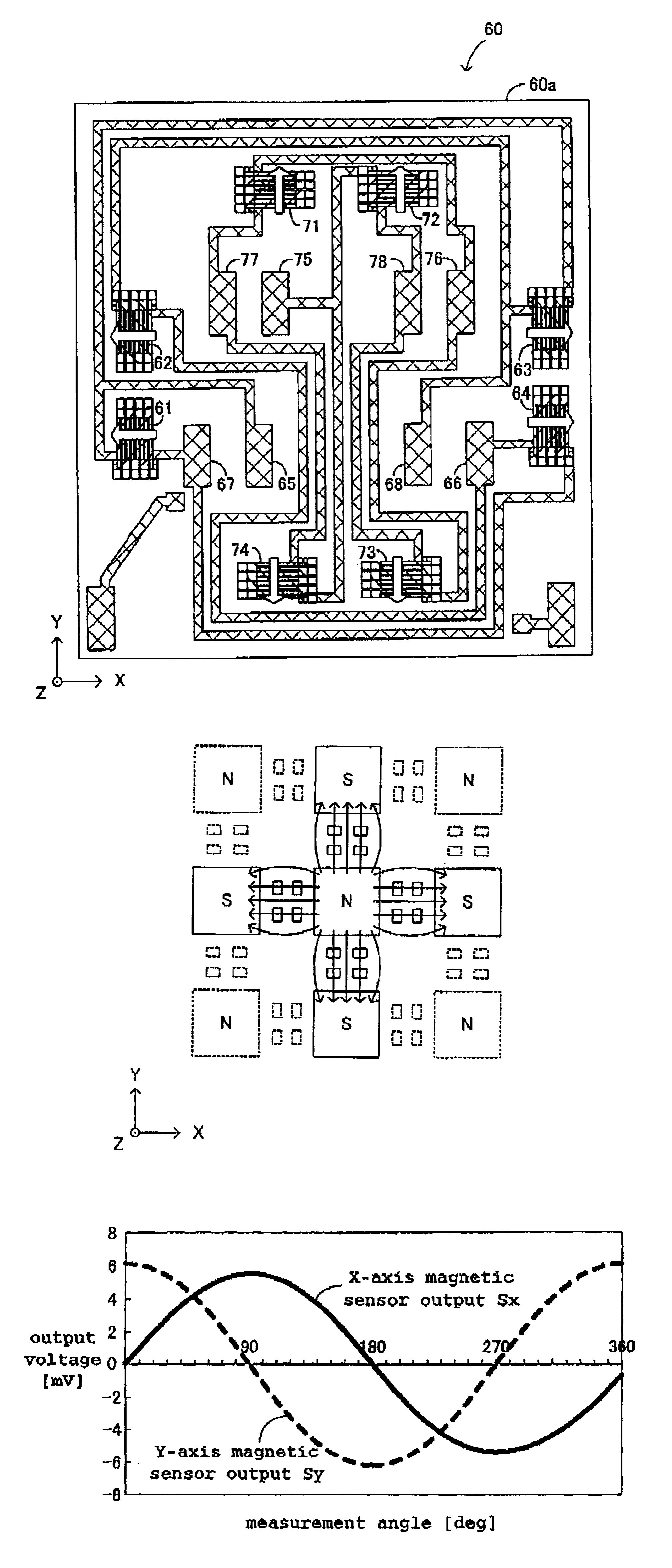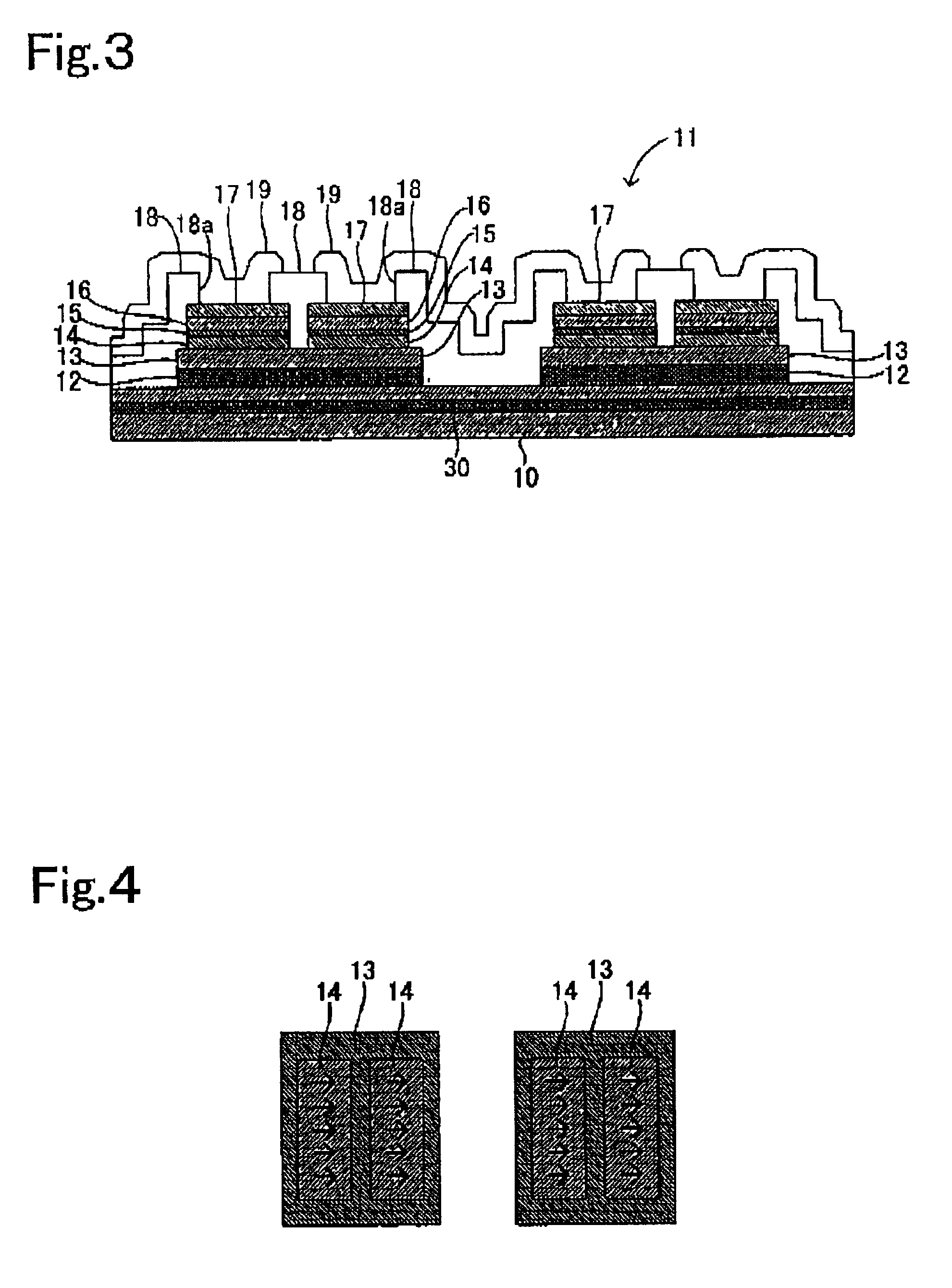Magnetic sensor and method of producing the same
a technology of magnetoresistance effect and magnetic sensor, which is applied in the field of magnetic sensor, can solve the problems of inability to have a wider application range of magnetic sensors made of a single chip using a magnetoresistance effect element, and it is difficult to form two or more magnetoresistance effect elements on a single minute chip, so as to achieve the effect of easy production and easy production
- Summary
- Abstract
- Description
- Claims
- Application Information
AI Technical Summary
Benefits of technology
Problems solved by technology
Method used
Image
Examples
first embodiment
[0073]Hereafter, embodiments of the magnetic sensor according to the present invention will be described with reference to the attached drawings. The magnetic sensor includes a generally square-shaped substrate 10 made of, for example, SiO2 / Si, glass, or quartz, two magnetic tunnel affect elements (groups) 11, 21, a coil 30 for bias magnetic field, and a plurality of electrode pads 40a to 40f, as illustrated in the plan view of FIG. 1. Magnetic tunnel effect elements (groups) 11, 21 and coil 30 for bias magnetic field are connected respectively to electrode pads 40a, 40b, 40c, 40d, and 40e, 40f. Since magnetic tunnel effect element (group) 11 and magnetic tunnel effect element (group) 21 are identical in structure, magnetic tunnel effect element (group) 11 will be described hereafter as a representative example, and the description of magnetic tunnel effect element (group) 21 will be omitted.
[0074]Magnetic tunnel effect element (group) 11 is made of a plurality of (in this example,...
second embodiment
[0094]Namely, in the second embodiment, as illustrated in FIG. 22, a film made of Ta having a thickness of 30 nm, a film made of MnRh having a thickness of 30 nm, and a film made of NiFe having a thickness of 40 nm are formed on a substrate 10 by sputtering so as to form a lower magnetic layer SJ. Subsequently, an Al film of 1 nm is formed and oxidized to form an insulating layer 15. A film made of NiFe having a thickness of 40 nm and a film made of Ta having a thickness of 40 nm are formed thereon so as to form an upper magnetic layer UJ.
[0095]Subsequently, as illustrated In FIG. 23, the upper magnetic layer UJ is processed for separation, and the lower magnetic layer SJ is processed for separation, as illustrated in FIG. 24. Next, as illustrated in FIG. 25, SiO2 is sputtered to form a film having a thickness of 250 nm so as to form an interlayer insulating layer 18, and successively a contact hole 18a is formed through the interlayer insulating layer 18, as illustrated in FIG. 26....
third embodiment
[0126]As described above, a magnet array is prepared which is constructed in such a manner that a plurality of permanent magnets are disposed at lattice points of a square lattice and the polarity of the magnetic pole of each permanent magnet is different from the polarity of the magnetic pole of the other permanent magnets adjacent thereto and spaced apart therefrom by the shortest distance, and the magnetization direction of the magnetic layer that will become the aforesaid pinned layer is pinned with the use of the magnetic fields formed by the magnet array. Therefore, on a single chip, one can easily form GMR elements in which the pinned magnetization directions of the pinned layers are different from each other (perpendicular to each other). Further, by this method, one can produce single chips each having GMR elements in which the pinned magnetization directions of the pinned layers are different from each other, at a time and in a large amount, thereby leading to reduction i...
PUM
| Property | Measurement | Unit |
|---|---|---|
| thickness | aaaaa | aaaaa |
| thickness | aaaaa | aaaaa |
| thickness | aaaaa | aaaaa |
Abstract
Description
Claims
Application Information
 Login to View More
Login to View More - R&D
- Intellectual Property
- Life Sciences
- Materials
- Tech Scout
- Unparalleled Data Quality
- Higher Quality Content
- 60% Fewer Hallucinations
Browse by: Latest US Patents, China's latest patents, Technical Efficacy Thesaurus, Application Domain, Technology Topic, Popular Technical Reports.
© 2025 PatSnap. All rights reserved.Legal|Privacy policy|Modern Slavery Act Transparency Statement|Sitemap|About US| Contact US: help@patsnap.com



